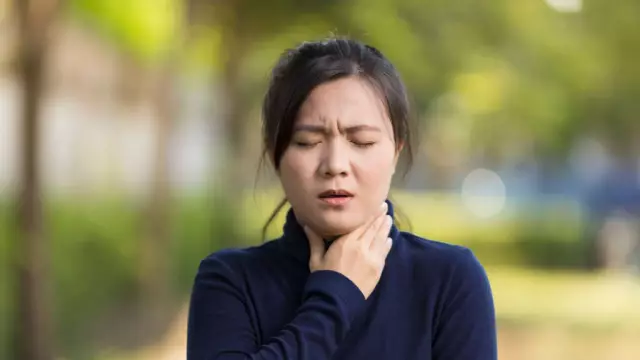- Author Rachel Wainwright [email protected].
- Public 2023-12-15 07:39.
- Last modified 2025-11-02 20:14.
Polydactyly
Polydactyly is a congenital pathology of the development of fingers, which is expressed in an increase in their number. It is more often observed on the hands, but it can also affect the toes, or both the upper and lower extremities.

As a rule, this anatomical defect is inherited as a dominant trait in polydactyly in one of the parents. It is not life threatening, but it can cause psychological trauma, impair the function of the limbs, as well as slow down physical development and limit career choices in the future.
According to statistics, polydactyly occurs with the same frequency in boys and girls. According to various sources, it is observed in one of 660-3300 infants and can be combined with other hereditary disorders of the musculoskeletal system, such as syndacthelia, brachydactyly and joint dysplasia.
Causes of polydactyly
The etiology of the development of polydactyly is not well understood, but a genetic predisposition is considered the main reason. The probability of inheriting the anomaly is 50%, since the dominant feature of polydactyly is characterized by a low degree of penetrance. Thus, a healthy child can be born to the carrier of the gene.
According to some versions, pathology can occur in an embryo at 5-8 weeks of development due to an uneven increase in the number of mesodermal cells. In addition, sometimes it is just one symptom of a serious gene or chromosomal disorder. Medicine knows about 120 syndromes that can be accompanied by polydactyly, among which are:
- Rubinstein-Tybee syndrome;
- Carpenter's syndrome;
- Smith-Lemli-Opitz Syndrome;
- Laurens-Moon-Biedl syndrome;
- Chondroectodermal dysplasia;
- Trisomy 13;
- Thoracic dystrophy with asphyxiation.
It is often impossible to establish the exact cause of the extra fingers.
Classification of polydactyly
Polydactyly is classified according to localization and type of doubling. Depending on which fingers are duplicated, three types of anomaly are distinguished:
- Preaxial (radial) - thumb;
- Central - index, middle and unnamed;
- Postaxial (ulnar) - little finger.
Additional fingers, both on the hands and on the feet, can be formed in different ways, on which their quality characteristics and functionality depend. Depending on the type of doubling that took place, they can represent the following formations:
- Rudiment. Composed of soft tissue, boneless. It rests on a skin leg. Non-functional;
- Forked main toe. It is formed as a result of duplication of the corresponding metacarpal or metatarsal bone. Almost always underdeveloped and has fewer phalanges;
- A full finger. Has a normal size and shape.
With polydactyly at the site of the lesion, deformation of the bones and joints is often observed, which over time can progress and lead to secondary changes in the osteoarticular apparatus.
Diagnosis of pathology
Polydactyly is diagnosed using clinical, genetic, radiological, biomechanical and other research methods. Clinical examination of the child is carried out by a pediatrician, orthopedist and geneticist in order to identify functional and anatomical developmental disorders, as well as to establish the type of inheritance of polydactyly. An X-ray of the affected hand or foot is imperative to assess the condition of the articular and bone apparatus. If necessary, examination of cartilaginous structures and soft tissues is performed by magnetic resonance imaging. Additional methods, such as stabilography and electromyography, can complement the results obtained.
Genetic analysis is aimed at making a prediction of the probability of giving birth to a given couple of a child with an anatomical anomaly. Since the autosomal dominant mode of inheritance of polydactyly is most characteristic, it is enough for the development of the disease that the mutant allele is passed on from one of the parents.
If six-toed is a symptom of a chromosomal or genetic abnormality, then careful prenatal diagnosis is necessary, which includes amniocentesis and chorionic biopsy, as well as ultrasound examination. With isolated polydactyly, pregnancy is recommended to be preserved, and in case of chromosomal abnormalities, it is recommended to interrupt.
Treatment of polydactyly

Treatment of polydactyly is carried out exclusively by surgery. If the extra fingers are soft tissue, they are removed in the first months after birth. In other cases, surgery is resorted to no earlier than a year later. This is necessary in order to study the condition of the main fingers, which cannot be done in a newborn.
Clinical data indicate that after the usual removal of the accessory phalanges, repeated deformity develops in 70% of cases. Therefore, during the operation, the elimination of the accessory phalanges can be combined with the correction of the deformation of the main fingers or with their restoration using the removed tissues. The duration of the recovery period also depends on this. Sometimes it can take several years for the functions of the hands or feet to return to normal.
Isolated polydactyly responds best to treatment at an early age. If this pathology is a consequence of a chromosomal or gene syndrome, then the prognosis depends on the severity of the underlying disease.
Prevention of polydactyly consists in conducting genetic counseling during pregnancy planning, and subsequently in the implementation of prenatal diagnosis.
YouTube video related to the article:
The information is generalized and provided for informational purposes only. At the first sign of illness, see your doctor. Self-medication is hazardous to health!






